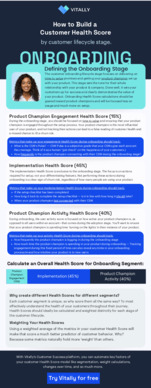
Guide to Building B2B SaaS Customer Health Scores for Every Stage of the Customer Lifecycle

In an ideal world, if a customer is not satisfied with your product, they would tell you they were thinking of leaving, giving your team an opportunity to improve and, hopefully, win them back before they churn. However, in the real world, SaaS businesses have Customer Health Scores—a tool that helps businesses predict churn and gauge how healthy a customer’s relationship is with their product.
Many Health Scoring models exist, with some being more reliable than others. But what makes a reliable Health Score? One where customers are scored uniquely based on contextual factors, namely where they land in the customer lifecycle. Here’s another way to think about it; you can’t use the same Health Scores for all lifecycle stages because a customer’s behavior changes as they mature with your product.
Keeping that in mind, we at Vitally wanted to share our best-practice guides to building customer Health Scores by customer lifecycle stages i.e. Onboarding, Adoption, Maturity, and Renewal. So, why can’t you use the same health scores for all lifecycle stages? Simply put, a customer’s behavior changes as they mature with your product.
Your customers will naturally take different actions in your product when they first sign on vs. the actions they will take after using your product for a while. For example, you won’t see high usage rates from a new customer who’s setting up your product. On the flip side, you wouldn’t expect a long-time customer to still be enabling many new integrations.
Not only will customer usage differ from stage to stage, but *what* usage matters will also change from stage to stage. For an onboarding customer, we may not yet care about how much usage they are driving, but more so that they have turned on and set up certain modules or key integrations, while the inverse may be true for mature and established customers.
Calculating health scores uniformly without regard to lifecycle stage—or even other aspects, like industry, size, etc.—is a recipe for creating an unreliable, non-trustworthy, and in-actionable set of Health Scores.